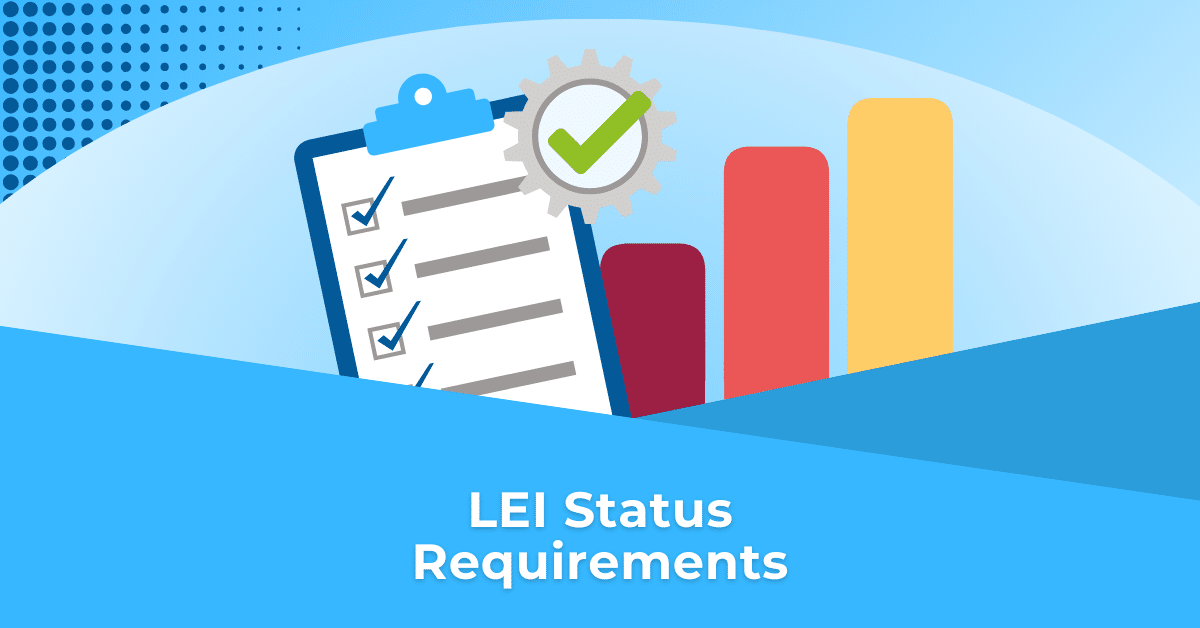There are certain fields within the reporting regimes of EMIR, MiFIR, SFTR, ASIC, MAS and Canada, which require populating with a legal entity identifier (LEI). All LEIs for these reporting regimes must be valid and included in the GLEIF database. (For more information on ISO 17442 see GLEIF’s website).
As a general overview:
- for new transactions, LEIs for the reporting counterparty (i.e. Counterparty 1) cannot be lapsed, and must have a status as per GLEIF, such as:
- “Issued”;
- “Pending transfer”; or
- “Pending archival”;
- for the other counterparty within a trade, their LEI is able to be “Lapsed” with GLEIF; and
- the Initial Registration Date of an LEI must be equal to or after the trade date.
For each regime we summarise the primary fields which require LEIs to be populated, along with whether the LEI can be lapsed or not. The regimes differ in terms of specific validation rules and action types, even though field names may be similar in some cases.
GLEIF LEI statuses and what they mean?
The below are the most commonly used LEI statuses as set out by GLEIF along with their meanings:
- Lapsed – The LEI is overdue for annual renewal
- Pending transfer – A transfer has been requested for a transfer to a new managing LOU (i.e. a new LEI issuer).
- Pending archival – In the process of a transfer to a new managing LOU.
- Issued – an LEI that has been validated and issued.
Other LEI statuses that are used on GLEIF:
- Annulled – Marked as an error after the LEI has been issued.
- Duplicate – There is a duplicate LEI registration.
- Retired – Operation has ceased other than due to ‘Merged’ below.
- Merged – Due to a merger, no longer operating as a legal entity.
For more information on LEIs, see our articles here and here.
Regimes and LEI fields for population and validation
EU EMIR
| Field | Action Type | Validation | Additional Information |
|---|---|---|---|
| Report submitting entity ID | NEWT – New MODI – Modify REVI – Revive CORR – Correct VALU – Valuation POSC – Position component MARU – Margin update | The status of the LEI must be: “Issued”, “Lapsed”, “Pending Transfer” or “Pending Archival” only. | – |
| TERM – Termination EROR – Error | LEI can be any status | ||
| Entity responsible for reporting | NEWT – New MODI – Modify CORR – Correct VALU – Valuation POSC – Position component | The status of the LEI must be: “Issued”, “Pending Transfer” or “Pending Archival” only. | LEI cannot be lapsed in order to submit, except for Action Type “TERM”, “REVI” or “EROR”. |
| TERM – Termination REVI – Revive EROR – Error | LEI can be any status. | ||
| Counterparty 1 (Reporting Counterparty) | NEWT – New MODI – Modify CORR – Correct VALU – Valuation POSC – Position component MARU – Margin update | The status of the LEI must be: “Issued”, “Pending transfer” or “Pending Archival” only. | LEI cannot be lapsed in order to submit, except for Action Type “TERM”, “REVI” or “EROR”. |
| TERM – Termination REVI – Revive EROR – Error | LEI can be any status. | ||
| Counterparty 2 | NEWT – New MODI – Modify CORR – Correct VALU – Valuation POSC – Position component MARU – Margin update | The status of the LEI must be: “Pending transfer” or “Pending archival” only. | LEI cannot be lapsed in order to submit, except for Action Type “TERM”, “REVI” or “EROR”. |
| TERM – Termination REVI – Revive EROR – Error | LEI can be any status. | ||
| Broker ID | Not specified. | LEI must be a valid LEI as per the GLEIF database. | – |
| Clearing Member | Not specified. | LEI must be a valid LEI as per the GLEIF database. | – |
| Central counterparty | Not specified. | LEI must be a valid LEI as per the GLEIF database. | – |
| PTRR service provider | Not specified. | LEI must be a valid LEI as per the GLEIF database. | – |
| PTRR service provider | Not specified. | LEI must be a valid LEI as per the GLEIF database. The LEI does not need to be in ‘Active’ status. If NPID (Natural person identifier) is used, then the first 20 characters must be a valid LEI as per GLEIF. | – |
| Reference entity (for Credit Derivatives) | Not specified. | LEI must be a valid LEI as per the GLEIF database, if used instead of the country code. | – |
UK EMIR
| Field | Action Type | Validation | Additional Information |
|---|---|---|---|
| Report submitting entity ID | NEWT – New MODI – Modify REVI – Revive CORR – Correct VALU – Valuation POSC – Position component | The status of the LEI must be: “Issued”, “Lapsed”, “Pending transfer” or “Pending Archival” only. | – |
| TERM – Termination EROR – Error | LEI can be any status. | ||
| Entity responsible for reporting | NEWT – New MODI – Modify CORR – Correct VALU – Valuation POSC – Position component | The status of the LEI must be: “Issued”, “Pending Transfer” or “Pending Archival” only. | LEI cannot be lapsed in order to submit, except for Action Type “TERM”, “REVI” or “EROR”. |
| TERM – Termination REVI – Revive EROR – Error | LEI can be any status. | ||
| Counterparty 1 (Reporting Counterparty) | NEWT – New MODI – Modify CORR – Correct VALU – Valuation POSC – Position component | The status of the LEI must be: “Issued”, “Pending transfer” or “Pending Archival” only. | LEI cannot be lapsed in order to submit, except for Action Type “TERM”, “REVI” or “EROR”. |
| TERM – Termination REVI – Revive EROR – Error | LEI can be any status. | ||
| Counterparty 2 | NEWT – New MODI – Modify CORR – Correct VALU – Valuation POSC – Position component | The status of the LEI must be: “Issued”, “Lapsed”, “Pending transfer” or “Pending archival” only. | – |
| TERM – Termination REVI – Revive EROR – Error | LEI can be any status. | ||
| Execution Agent | NEWT- New MODI – Modify CORR – Correct POSC – Position component | The status of the LEI must be: “Issued”, “Pending transfer” or “Pending Archival” only. | LEI cannot be lapsed in order to submit, except for Action Type “REVI”. |
| REVI – Revive | LEI can be any status. |
MiFIR
| Field | Validation | Additional Information |
|---|---|---|
| Executing Entity ID | The status of the LEI must be “Issued”, “Pending transfer” or “Pending archival”. | LEI cannot be lapsed in order to submit. |
| Submitting Entity ID | The status of the LEI must be “Issued”, “Lapsed”, “Pending Transfer” or “Pending Archival”. | – |
| Buyer/Seller IDs | The status of the LEI must be “Issued”, “Lapsed”, “Pending transfer” or “Pending archival”. | – |
| Buyer/Seller Decision Maker IDs | The status of the LEI must be “Issued”, “Lapsed”, “Pending transfer” or “Pending archival”. | – |
| Buyer Transmitter ID | The status of the LEI must be “Issued”, “Lapsed”, “Pending transfer” or “Pending archival”. | – |
| Seller Transmitter ID | The status of the LEI must be “Issued”, “Lapsed”, “Pending transfer” or “Pending archival”. | – |
SFTR
| Field | Action Type | Validation | Additional Information |
|---|---|---|---|
| Report submitting entity | NEWT – New MODI – Modify VALU – Valuation COLU – Collateral update ETRM – Early Termination CORR – Correction POSC – Position component REUU – Collateral reuse update MARU – Margin update | The status of the LEI must be “Issued”, “Pending transfer” or “Pending archival”. | LEI cannot be lapsed in order to submit, except for action type “EROR”. |
| EROR – Error | LEI can be any status. | ||
| Reporting counterparty | NEWT – New MODI – Modify VALU – Valuation COLU – Collateral update CORR – Correction POSC – Position component MARU – Margin update REUU – Collateral reuse update | The status of the LEI must be “Issued”, “Pending transfer” or “Pending Archival”. | LEI cannot be lapsed in order to submit, except for action type “EROR” or “ETRM”. |
| ETRM – Early Termination | LEI can also be “Lapsed” or “Retired”. | ||
| EROR – Error | LEI can be any status. | ||
| Entity responsible for the report | NEWT – New MODI – Modify VALU – Valuation COLU – Collateral update CORR – Correction POSC – Position component EROR – Error | The status of the LEI must be “Issued”, “Pending transfer” or “Pending archival”. | LEI cannot be lapsed in order to submit, except for action type “EROR” or “ETRM”. |
| ETRM – Early Termination | LEI can also be “Lapsed” or “Retired”. | ||
| EROR – Error | LEI can be any status. | ||
| Other Counterparty | NEWT – New MODI – Modify CORR – Correction COLU – Collateral update VALU – Valuation POSC – Position component | The status of the LEI must be “Issued”, “Lapsed”, “Pending transfer” or “Pending Archival”. | – |
| ETRM – Early Termination | LEI can also be “Retired”. | ||
| EROR – Error | LEI can be any status. |
ASIC
| Field | Action Type | Validation | Additional Information |
|---|---|---|---|
| Reporting Counterparty | NEWT – New MODI – Modify CORR – Correct VALU – Valuation MARU – Margin update | The status of the LEI must be: “Issued”, “Pending transfer” or “Pending Archival”. | LEI is able to be lapsed in instances where there is no ‘current LEI’ (i.e. LEI has been [retired]). |
| REVI – Revive TERM – Termination EROR – Error PRTO -Transfer out | LEI can be any status. | ||
| Counterparty 1 | NEWT – New MODI – Modify CORR – Correct VALU – Valuation MARU – Margin update | The status of the LEI must be: “Issued”, “Pending transfer” or “Pending Archival”. | LEI is able to be lapsed in instances where there is no ‘current LEI’ (i.e. LEI has been [retired]. |
| REVI – Revive TERM – Termination EROR – Error PRTO – Transfer out | LEI can be any status. | ||
| Counterparty 2 | NEWT – New MODI – Modify CORR – Correct VALU – Valuation MARU – Margin update | The status of the LEI must be: “Issued”, “Lapsed”, “Pending transfer” or “Pending Archival”. | – |
| REVI – Revive TERM – Termination EROR – Error PRTO – Transfer out | LEI can be any status. | ||
| Beneficiary 1 | NEWT – New MODI – Modify CORR – Correct | The status of the LEI must be: “Issued”, “Lapsed”, “Pending transfer” or “Pending Archival”. | – |
| REVI – Revive | LEI can be any status. | ||
| Broker | NEWT – New MODI – Modify CORR – Correct REVI – Revive | The status of the LEI must be: “Issued”, “Lapsed”, “Pending transfer” or “Pending Archival”. | – |
| Execution Agent of Counterparty 1 | NEWT – New MARU – Margin update MODI – Modify VALU – Valuation CORR – Correct | The status of the LEI must be: “Issued”, “Lapsed”, “Pending transfer” or “Pending Archival”. | – |
| REVI – Revive TERM – Termination EROR – Error PRTO – Transfer out | LEI can be any status. |
MAS
| Field | Action Type | Validation | Additional Information |
|---|---|---|---|
| Counterparty 1 | NEWT – New MODI – Modify CORR – Correct VALU – Valuation MARU – Margin update | The status of the LEI must be: “Issued”, “Pending transfer” or “Pending Archival”. | LEI cannot be lapsed in order to submit, except for action type “REVI”, “TERM”, “EROR” and “PRTO”. |
| REVI – Revive TERM – Termination EROR – Error PRTO – Transfer out | LEI can be any status. | ||
| Counterparty 2 | NEWT – New MODI – Modify CORR – Correct VALU – Valuation MARU – Margin update | The status of the LEI must be: “Issued”, “Lapsed”, “Pending transfer” or “Pending Archival”. | – |
| REVI – Revive TERM – Termination EROR – Error PRTO – Transfer out | LEI can be any status. | ||
| Reporting specified person | NEWT – New MODI – Modify CORR – Correct VALU – Valuation MARU – Margin update | The status of the LEI must be: “Issued”, “Pending transfer” or “Pending Archival”. | LEI cannot be lapsed in order to submit, except for action type “REVI”, “TERM”, “EROR” and “PRTO”. |
| REVI – Revive TERM – Termination EROR – Error PRTO – Transfer out | LEI can be any status. | ||
| Data submitter | NEWT – New MODI – Modify CORR – Correct REVI – Revive VALU – Valuation MARU – Margin update | The status of the LEI must be: “Issued”, “Lapsed”, “Pending transfer” or “Pending Archival”. | – |
| TERM – Termination EROR – Error PRTO – Transfer out | LEI can be any status. |
Canada
| Field | Action Type | Validation |
|---|---|---|
| Clearing Venue – ID | Not specified. | If populated, LEI must be a valid LEI as per the GLEIF database. The LEI does not need to be in ‘Active’ status. |
| Trade Party 1 – Clearing Broker ID | Not specified. | LEI must be a valid LEI as per the GLEIF database. The LEI does not need to be in ‘Active’ status. If NPID (Natural person identifier) is used, then the first 20 characters must be a valid LEI as per GLEIF. |
| Original Swap SDR – ID | NEWT – New | LEI must be a valid LEI as per the GLEIF database. The LEI does not need to be in ‘Active’ status. |
| Trade Party 1 – ID | Not specified. | LEI must be a valid LEI as per the GLEIF database. The LEI does not need to be in ‘Active’ status. If NPID (Natural person identifier) is used, then the first 20 characters must be a valid LEI as per GLEIF. |
| Trade Party 2 – ID | Not specified. | LEI must be a valid LEI as per the GLEIF database. The LEI does not need to be in ‘Active’ status. If NPID (Natural person identifier) is used, then the first 20 characters must be a valid LEI as per GLEIF. |
| TERM – Termination EROR – Error PRTO – Transfer out | Up to 200 characters are accepted to allow clean up or porting out of legacy data. | |
| Submitting Party – ID | Not specified. | LEI must be a valid LEI as per the GLEIF database. The LEI does not need to be in ‘Active’ status. |
| Trade Party 2 – Execution Agent ID | Not specified. | LEI must be a valid LEI as per the GLEIF database. The LEI does not need to be in ‘Active’ status. |
| Execution Venue – ID | Not specified. | LEI must be a valid LEI as per the GLEIF database. The LEI does not need to be in ‘Active’ status. |
| Trade Party 1 – Broker ID | Not specified. | If populated, LEI must be a valid LEI as per the GLEIF database. The LEI does not need to be in ‘Active’ status. |
| Responsible Data Submitter – ID | Not specified. | LEI must be a valid LEI |
| Corporate Action – New Trade Party 1 LEI | MODI – modify | LEI must be a valid LEI as per the GLEIF database. The LEI does not need to be in ‘Active’ status. |
How can TRAction assist?
TRAction, as a third-party service provider, closely monitors the LEI requirements and ensures our clients are compliant with the latest changes under the new regulations. We assist our clients in obtaining and renewing LEIs and also ensure our clients report their LEIs accurately and consistently.
If you would like to discuss the process of getting or renewing LEIs or in relation to LEI statuses for your transactions, please do not hesitate to contact us.




